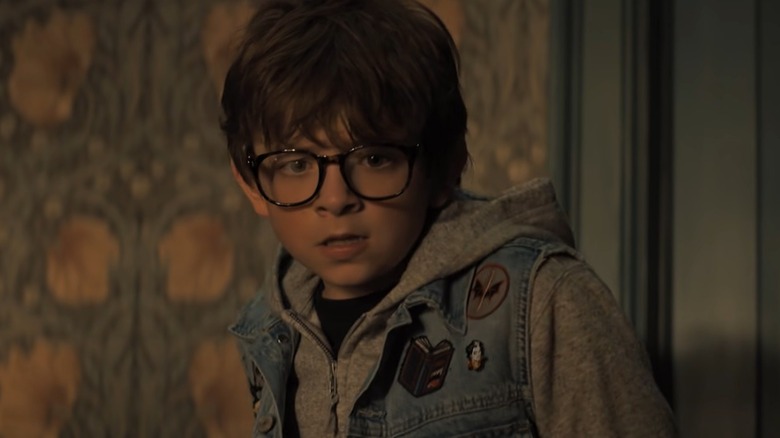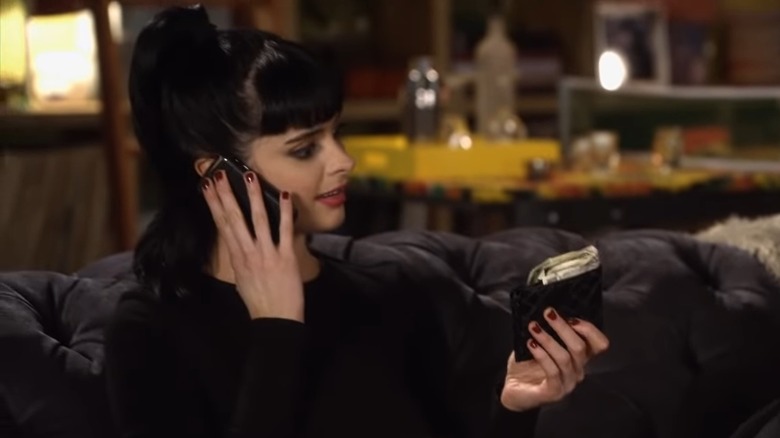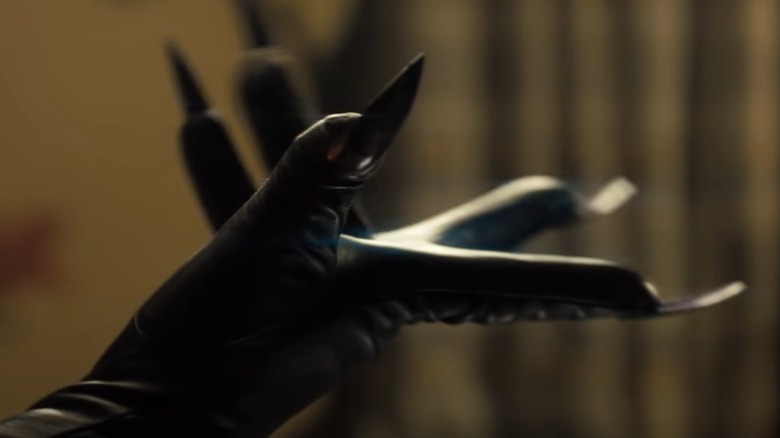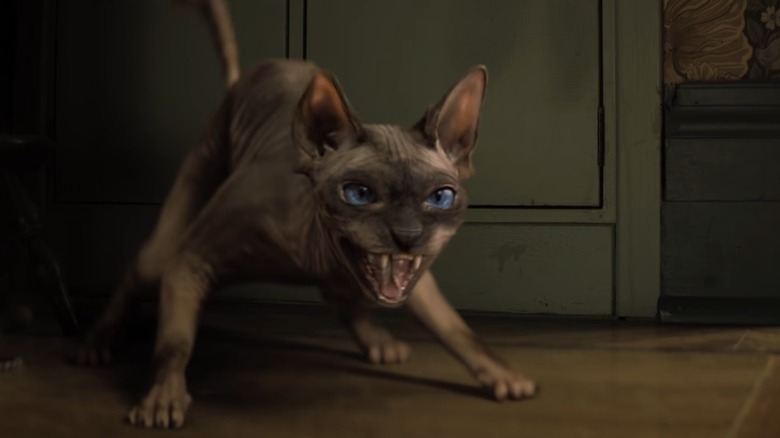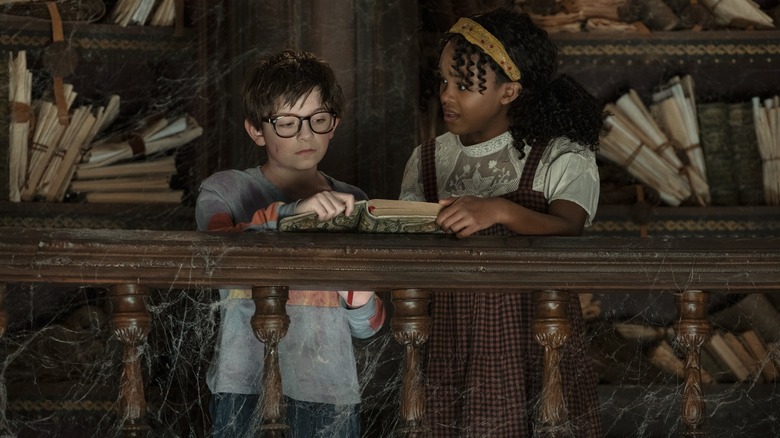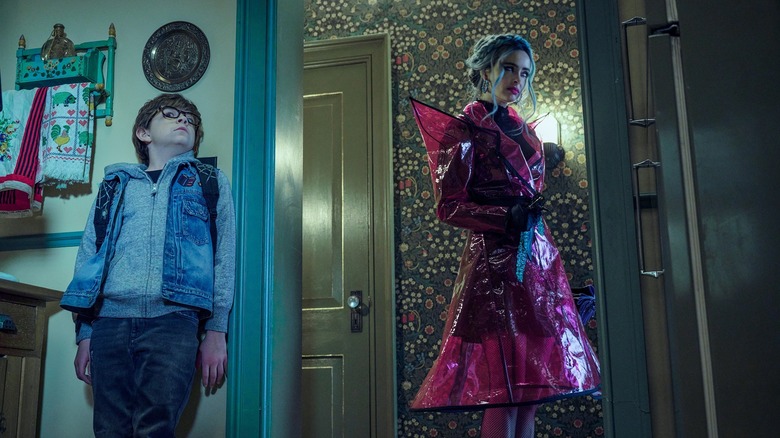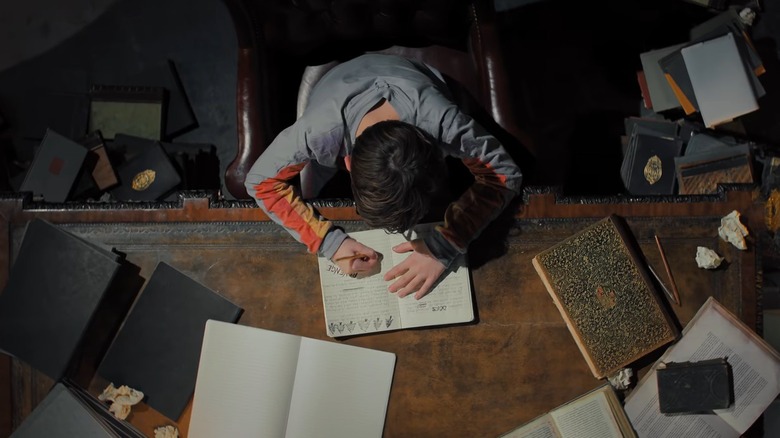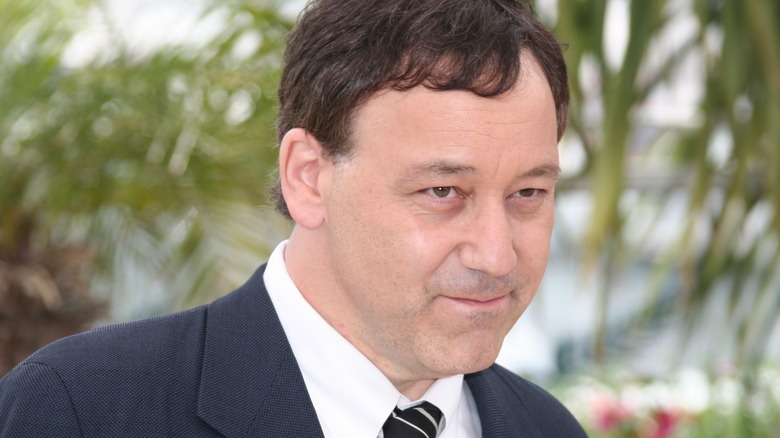Things Only Adults Notice In Nightbooks
This content was paid for by Netflix and created by Looper.
Netflix's "Nightbooks" is a horror movie for kids that's actually pretty scary. Based on a 2018 book by J.A. White, the film tells the story of Alex (Winslow Fegley), a boy from New York City who loves horror. He watches horror movies, reads horror books, and most importantly, writes horror stories. But his obsession with the macabre makes him seem weird to other kids, and he feels like an outcast.
One night, after a particularly traumatic social mishap, Alex vows to stop writing horror stories –- which he collects in his "nightbooks" –- and start being normal. Unfortunately, he's soon lured into a spooky apartment by a slice of pumpkin pie and a TV playing the teen horror classic "The Lost Boys." But soon, he discovers he's trapped inside the magical apartment, which is presided over by an evil witch named Natacha (Krysten Ritter). The apartment's other residents are another imprisoned kid named Yasmin (Lidya Jewett), and Lenore, a hairless cat that can turn invisible. Natacha is keeping them all around for a reason, and Alex is there because Natacha needs to hear a new scary story every night. So Alex has to read from his nightbooks and keep her entertained ... or else.
"Nightbooks" is a clever mashup of "One Thousand and One Nights" and "Hansel and Gretel," with a heavy dose of horror history. The film has many allusions to classic scary stories, both literary and cinematic. Kids watching may not pick up on the references yet -– "Nightbooks" seems designed to be a gateway to horror classics –- but adults will surely notice them and a whole lot more.
Alex is literally a lost boy
One of Alex's favorite movies is "The Lost Boys," the classic 1987 horror-comedy. It also turns out to be his downfall as Natacha knew the movie would lure him into her terrifying lair. After all, he has a "Lost Boys" poster on his bedroom wall, and he seems to relate to the frightening flick.
So what's "The Lost Boys" about? Well, it follows brothers Michael (Jason Patric) and Sam Emerson (Corey Haim), who get involved with a crew of teenage vampires living in their California beach town. After Michael unwittingly becomes a half-vampire, the Emersons team up with another pair of brothers, Edgar (Corey Feldman) and Alan Frog (Jamison Newlander), to try to defeat the bloodsuckers before they can turn Michael into a full-on creature of the night.
The use of "The Lost Boys" in "Nightbooks" is no coincidence because Alex's story has some similarities to the beloved '80s film. He's a kid who discovers a secret horror plot happening right under his nose, like the Emerson brothers, and he knows everything about horror, like the vampire-hunting Frog brothers. It's probably also intentional that Winslow Fegley in "Nightbooks" bears some resemblance to young Corey Feldman. The glasses Alex wears in the movie are reminiscent of the ones Feldman wore in "Stand by Me."
Don't Trust the Witch in Apartment 23
Okay, this one isn't a horror connection, but it is something only adults would know (unless there's a 11-year-old out there who's obsessed with canceled early 2010s sitcoms).
After her star-making run on "Breaking Bad" as Jesse Pinkman's (Aaron Paul) heroin-addicted girlfriend, Jane Margolis, but before she became an action heroine as the super-strong, super-troubled private investigator on "Jessica Jones," Krysten Ritter starred on a low-rated but cultishly beloved comedy series called "Don't Trust the B—- in Apartment 23." It ran for two seasons on ABC between 2012 and 2013, and Ritter played Chloe, a New York City resident who welcomes new roommates into her apartment, takes their rent money up front, and then drives them out with her outrageous behavior. Chloe is kind of like a less evil but equally sarcastic and abrasive Natacha. In other words, Ritter is exceptionally good at playing mean but weirdly charming characters.
Like Chloe from "Apartment 23," Natacha is also an untrustworthy fashionista with an apartment that causes serious problems for people who enter it. The difference is people can't leave Natacha's apartment, and they can't leave Chloe's fast enough.
One, two, she's coming for you
Part of Natacha's costume design calls to mind another horror movie baddie who preyed on the young. Her gloves have claws, and while kids watching the movie might not know who else wears a razor-sharp mitten, parents definitely do. We're talking, of course, about Freddy Krueger, the villain of the "Nightmare on Elm Street” franchise.
Freddy, as played by Robert Englund, is the malevolent spirit of a serial killer, one who enters the dreams of children and teenagers and brutally murders them. When that happens, they also die in real life. And while his kills are often pretty inventive, his preferred weapon is a leather glove with steel blades that he made himself. He first appeared in 1984's "A Nightmare on Elm Street" and quickly became one of the most iconic horror characters.
Natacha's gloves are significantly different from Freddy's –- the claws are just long nails instead of razors, and she has two of them while Freddy only has one –- but they're similar enough among so many references to '80s horror that it doesn't feel like a coincidence that Freddy invades your imagination when you see them.
Lenore sounds familiar
Natacha has a pet hairless cat that can turn invisible in order to spy on Alex and Yasmin and report back with her findings. But it turns out that unlike a normal witch's familiar, the cat is a prisoner too. She doesn't want to serve Natacha, so she helps Alex and Yasmin escape.
The cat's name is Lenore, which is almost certainly a reference to the works of one of the creators of modern horror, Edgar Allan Poe. In Poe's famous poem "The Raven," the protagonist is grieving the loss of his beloved, who was named Lenore. Poe also has another, unrelated poem titled "Lenore," which is also about the tragic death of a young woman ("A dirge for her the doubly dead in that she died so young"). There's no direct connection between Poe's Lenore and Lenore the cat, but it's unlikely that J.A. White would write a story as informed by horror history and concerned with the craft of fiction as "Nightbooks" and not intend the name to be a Poe tribute.
'She does like stories.'
When Yasmin takes Alex to Natacha's enormous library for the first time, he's overjoyed to be in the presence of so many books packed full of scary stories. He runs up the spiral staircase and begins calling out the titles, which include "The Empty Classroom and Other Creepy Stories" and "Nightdreams and Daymares." And as you might've guessed, these titles are winking references to well-known horror collections.
"The Empty Classroom and Other Creepy Stories" sounds a lot like "The Empty House and Other Ghost Stories" by Algernon Blackwood. Blackwood was an English horror writer who penned his tales in the early 20th century. He was a major influence on horror legend H.P. Lovecraft, who considered Blackwood's novella "The Willows" among his favorites. (For the curious, "The Willows" follows two men on a canoe trip down a river that seems to have unnerving mystical powers.)
"Nightdreams and Daymares" actually echoes two different classic horror short story collections, Nelson Bond's "Nightmares and Daydreams" and Stephen King's "Nightmares and Dreamscapes." Nelson Bond was a pulp writer who worked from the 1930s to the 1950s and was a significant influence on the development of sci-fi horror. And "Nightmares and Dreamscapes" is one of Stephen King's many short story collections, which contains well-regarded stories like "Dolan's Cadillac" and "Chattery Teeth."
Nightbooks of the Hunter
When Alex tells stories from his nightbooks, they play out on-screen in a visual style that's different from the rest of the movie. The spooky stories have a dreamlike feel, with obviously artificial sets built with strange angles and bathed in dark shadows. The images are jerky and grainy and meant to look like the celluloid film of an old silent movie.
These sequences are tributes to German Expressionism, an artistic movement that flourished in film between World War I and World War II. Two of the most emblematic examples of German Expressionism in cinema are the silent horror films "The Cabinet of Dr. Caligari" and "Nosferatu," movies that developed the style "Nightbooks" imitates as a sort of loving parody.
German Expressionism influenced many later filmmakers, including Alfred Hitchcock, Werner Herzog, and Tim Burton. However, the film "Nightbooks" seems to be most closely imitating isn't actually a straight-up German Expressionist film but rather an American film from 1955 that's heavily influenced itself by German Expressionism. We're talking about Charles Laughton's incredibly creepy "The Night of the Hunter," which uses shadows and fog on unnatural sets to create an ominous mood for its story about children in peril.
A writer's life
"Nightbooks" has themes of self-acceptance and being a good friend that are designed to resonate with kids, but there are ideas about being a writer that are maybe pitched at people a little older.
When the witch tells Alex, "You wanna live? Write scary stories," real-life writers can totally relate. After all, their own brains probably tell them something similar, inspiring them to get to work so they can put food on the table, even though they don't necessarily want to. Alex is in a particularly dire situation, but it's just a heightened version of the emotional and financial insecurity that most writers go through. It's hard for Alex to see how his gifts as a storyteller have a practical application, especially compared to Yasmin, who can cook and clean and garden, but Natacha values them so much that she'll keep him alive in order to entertain her. The writer's life has many challenges, but the stories it produces are things of great worth.
Alex's writing for his life reminds us of a great Stephen King quote: "If you wrote something for which someone sent you a check, if you cashed the check, and it didn't bounce, and if you then paid the light bill with the money, I consider you talented." Alex didn't do something as prosaic as pay his light bill with his stories — he helped save the lives of himself and his friends, so King would probably consider him an exceptionally talented writer.
Play it again, Sam Raimi
"Nightbooks" is produced by Sam Raimi, one of the all-time great horror directors. Sure, Raimi is also super popular for directing the original "Spider-Man" trilogy, but he first made a name for himself with the "Evil Dead" franchise. The films follow the misadventures of Ash Williams, a guy who just wants to hang out with his friends at a cabin in the woods. Of course, those plans get turned upside down when he and his buddies accidentally unleash a horde of ancient demons, forcing Ash and his allies to fight back with chainsaws and shotguns over the course of three films.
In other words, these are the kinds of '80s horror movies that Alex loves. However, Raimi has done more horror than just "Evil Dead," and "Nightbooks" pays homage to one of his more modern flicks during the creepy climax. At the end of the movie, when Alex and Yasmin battle the original witch from "Hansel and Gretel," the scene bears some similarity to Sam Raimi's horror-comedy cult favorite "Drag Me to Hell." The witch kind of looks like the old woman who puts a curse on Alison Lohman's tortured loan officer, and both films have moments that are tense, funny, and gross at the same time. In "Drag Me to Hell," there's the fight in the car where the old woman gums Lohman's character on the face, and in "Nightbooks," there's the part when the witch vomits candy all over Alex and Yasmin. "Nightbooks" is directed by David Yarovesky, not Sam Raimi, but it's the kind of scary but darkly funny movie Raimi would make.
Having Sam Raimi work on an adaptation of one of his books has to be a dream come true for J.A. White. On his website, the author says 1981's "The Evil Dead" is one of his favorite movies.
